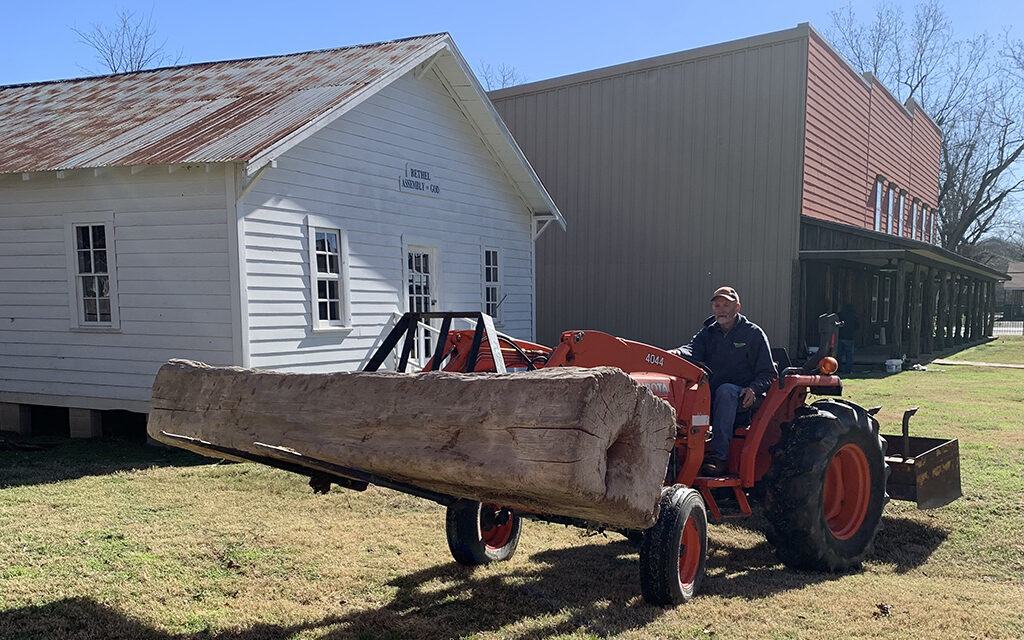A rather large artifact was moved into the Freestone County Historical Museum grounds recently.
This tanning vat was carved from a cottonwood tree and had been in use from the 1860’s.
Tim and Lea Hedrick of Teague donated the piece.

It had been handed down through the generations. Mr. Hedrick obtained the log from his grandfather, Paul Fulton of Donie.
“We are very proud to have such a historic item donated to the museum from the 1860’s,” said the folks at the Museum. “It is an awesome addition to our collection and it is so amazing that this artifact has survived over 160 years.”
When Linda and Marvin Mullen was unloading the log vat, they noticed letters carved inside. It appears to read the following: 1 IMA 1 Y.

If anyone has information about what these markings may be, please contact the museum at 903-389-3738.
The Freestone County Historical Museum is located at 302 East Main Street in Fairfield. They are open 10:00 a.m. to 5:00 p.m. on Wednesdays, Fridays and Saturdays.
Below is an article written by former Sheriff Sonny Sessions, who was an avid Freestone County historian. The article was previously published in the Freestone County Times on June 14, 2005.
Confederate Hide Tannery
In the mid l960’s Hugh Whitaker made me aware of a Hide Tannery that operated during the Civil War making leather that was used to make shoes for the soldiers and other needs. It was located about 5 miles east of present day Donie on a spring branch that became known as Tanyard Branch near Old Zion.
This Tannery was started shortly before the Civil War by Egbert Beall who came to Texas in the late l850’s. It is said the reason for Beall coming to Texas was his brother was killed at Goliad. For his brothers service in the Texas War for Independence and being killed at Goliad he received a league of land in Bell Co. After his marriage to a half Indian girl from the Keechi Reservation he traded this land for some Spanish horses as there no trees to build fences and such. They came to Old Zion near present Donie where he purchased land.
Beall operated a freight line from Houston and Galveston to Freestone Co. He built the first plank house in the area with lumber he brought in on this. The road trip to Houston and Galveston is reported to have taken about 3 months, feel sure oxen were used.
It is believed that this was the only tanning shop in this part of Texas. It is reported a large working force was required as this a big operation. Beall served in the Confederate forces during the War with the Tannery operated by his wife and slaves. A son John Beall was killed while fighting alongside his father in the War. The cowhide tanned was mostly made into shoes for the Confederate soldier.
Hugh Whitakers grandfather Robert came back with Egbert Beall at the end of the War to operate the Tanyard, which closed between l865 and l870. The vats used at the Tanyard were constructed of hewn logs, which were fitted together at the ends. The vats were about four feet above the ground. The cattle hides were soaked in the vats in water and oak tree bark. The oak bark acted as a tanning and preserving agent on the hides.
When Hugh Whitaker and I visited the site in the l960’s little was left. Impressions of the vats were still visible in the ground. It is reported there were 6 small vats 8’X 10’ and one larger 10’X 20’. Am sure nothing left here today as the area been mined for lignite for the utility plant.
Hugh Whitaker also reported his father J.L.R. Whitaker was one of the last to use oxen on his farm. The steers were named Brad and Barry. He was also the first to have an Oliver Walking Cultivator.
Much of this information came from Hugh Whitaker and a school paper done by one of his students Paul Smith in May 1965 on Texas History.
Egbert Beall lived in Donie until his death in l907 and burial in the Old Zion Cemetery where there once was also a church and school. The school consolidated with the Donie School District in l927.
*******
EDITORS NOTE: It must be noted that there were several creeks named “Tan Yard Brach” in Freestone County. One was in the Turlington Community, northeast of the Antioch Baptist Church according to the 1918 Freestone County Soil Survey Map. Another was a tributary of Keechi Creek between Plum Creek and Lanely, as noted on the 1964 Geological Survey Keechi Quadrangle map. Freestone County History Book Volume I, p. 500-501, mentions in the Joe Ervin and Hannah McAdams family history that Joe Ervin was skilled in carpentry and leatherwork. The Confederacy requested his services for making saddles and shoes for the soldiers. Much of his service time was spent at the Confederate Fort at Adkins Mill Pond near Mt. Zion. A tannery was set up where he produced leather goods.” This would be in the area that shows up on the Keechi Quadrangle. It was part of the Samuel Defer land grant.





